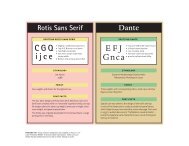Guidelines
Janson Text Pro.
Janson Text Pro.
- No tags were found...
Create successful ePaper yourself
Turn your PDF publications into a flip-book with our unique Google optimized e-Paper software.
Glossary<br />
Glossary of Typographic Terms:<br />
Font: Refers to a single and consistent size or style of a specific<br />
type family. For example, Helvetica Regular, Helvetica Italic and<br />
Helvetica Bold are three fonts, but one typeface.<br />
Typeface: Usually comprises an alphabet of letters, numbers<br />
and symbols. Typefaces can also be classified in one of two<br />
categories: Serif or Sans Serif.<br />
Kerning: Is the adjustment of spacing between specific pairs of<br />
letters. To “kern” is to make all spaces between each letter combination<br />
visually even.<br />
pairs pairs<br />
TOO OPEN<br />
VISUALLY EVEN<br />
Tracking: (A term often confused with kerning.) Tracking or letter<br />
spacing is the “regular” spacing between a group of characters or<br />
within a complete line of type. Word spacing is automatically adjusted<br />
when tracking is altered.<br />
letter space l e t t e r s p a c e<br />
REGULAR TRACKING (0) OPEN TRACKING (+160)<br />
x-height: Traditionally, x-height is the height of the lowercase<br />
letter x. It is also the height of the body of lowercase letters in a font,<br />
excluding the ascenders and descenders. The x-height can vary<br />
greatly from typeface to typeface at the same point size.<br />
ASCENDER<br />
x-height<br />
DESCENDER<br />
Glyph: The most common example of a glyph is a letter. Symbols<br />
and shapes in a font like ITC Zapf Dingbats are also glyphs.<br />
In a typeface each character typically corresponds to a single glyph,<br />
but there are exceptions, such as a font used for a language with<br />
a large character set (e.g., Chinese) or a complex writing system<br />
(e.g., Arabic), where one character may correspond to several glyphs<br />
or several characters to one glyph.<br />
Here are two examples of the “Glyphs” palette from Adobe InDesign.<br />
Serif: Small decorative strokes that are added to the end of a<br />
letter’s main strokes. Serifs improve readability by leading the eye<br />
along the line of type.<br />
Sans Serif: A typeface that does not have serifs. Sans Serif<br />
faces provide a clean and simple appearance to headings and<br />
blocks of text.<br />
Serif Sans Serif<br />
f<br />
f<br />
Latin: Covers North America and Western Europe.<br />
Extended Latin: Covers Central and Eastern European regions.<br />
Non-Latin: Covers Cyrillic, Greek, Arabic, Hebrew, Simplified<br />
Chinese, Traditional Chinese, Japanese and Korean.<br />
OpenType ® (OTF): The OpenType format can be used on both<br />
Macintosh and Windows platforms.<br />
67




